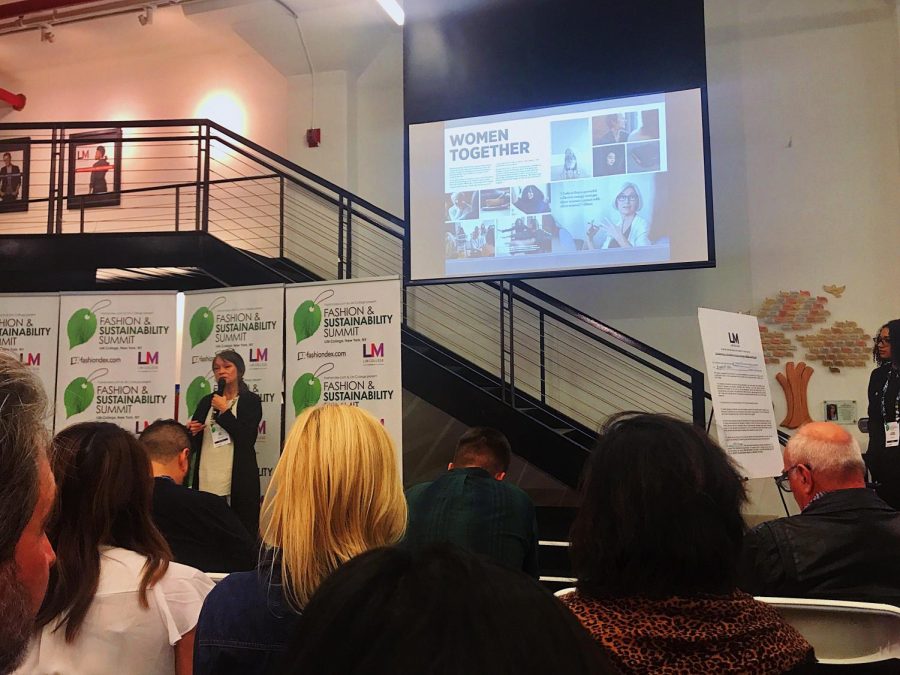As I took a look around Maxwell Hall at LIM College during Fashiondex and LIM’s third annual Sustainability Summit, I noticed I was in a room that was predominantly filled with women, ages ranging from 19 to 65. Sipping coffee and snacking on homemade cookies, these women were gearing their attention toward a panel of women speakers, with the exception of a few men.
LIM, a fashion business school in Manhattan, holds these summits for students, faculty, companies and environmentalists to have a common platform to speak on.
Fashion is one of the major polluters of the world — according to the Council for Textile Recycling, the average US citizen throws away 70 pounds of clothing and other textiles annually.
“Most clothing is made by women in factories in places like Bangladesh, India, China and Indonesia. These women are typically low income women,” Executive Director from Custom Collaborative, Ngozi Okaro said. Her focus is to bring these statistics to light and give these women a living wage and a clean and safe community.
Marc Yaggi of Waterkeeper Alliance made the point that about 20 percent of water pollution is from the fashion industry and also a result of garment making. The world uses 500 trillion liters of water for fabric dying alone – that’s enough to fill 32 Olympic-sized swimming pools every year.
Celine DeCarlo, the chief brand strategist of Mara Hoffman, discussed the need for change in the fashion industry as a whole. She presented the question, “How can we shift the workplace? How can companies be more sustainable?” Dr. Gayathri Banavara, a professor at LIM, offered the idea that companies have the most power and influence on people. She supported this by using the example of how Gucci stopped its sales of items with real fur, and more and more companies followed suit.
Dr. Banavara left the conversation with this: “The fashion industry has enough profit to be sustainable and provide equity for all its workers.”
Allison Sommer, director of Strategic Initiatives at The RealReal, an online luxury consignment store, talked about dismissing fast-fashion and opting for thrifting and consignment shopping as an alternative. We often discard the clothing we wear on our backs within the next year when new trends come about. Brands like H&M, Forever21 and ZARA are producers of fast-fashion and do not produce high-quality products.
“Luxury lasts. Even if you are not able to shop luxury consignment, just going thrifting or checking out smaller consignment stores are doing these women and this planet a favor. The clothes and accessories are unique, lasting, and not ending up in landfills,” Sommer said.
The fashion studies major in the College of Professional Studies examines not only the business aspects of the fashion industry but also its ethical aspects – including sustainability. Both Professor Andrea Licari, the Director of the St. John’s Fashion Studies Institute and Professor Almerinda Forte were in attendance at this summit.
FabScrap, a company that sold fabric at the St. John’s Fashion Major launch party, sent their founder, Jessica Schreiber to speak at the Summit. New York City law mandates that if 10 percent of your waste is textile, you must recycle, so Jessica created FabScrap to make some companies’ lives easier. FabScrap collects scraps of fabric from companies and manufacturers who have excess materials that would alternatively end up in landfills.
FabScrap sells these collected materials for cheap and will be opening a store in Chelsea this summer. They advise the best way to get rid of old clothing is by donating, because someone’s old is someone’s new.
Sometimes, donated clothes are even turned into art. Amy Hall,vice president of Social Consciousness for Eileen Fisher, showed an image of an art exhibit in Milan that was made entirely out of old clothes.
Sustainability is not a trend. The state of the Earth is concerning, and it does not take much to make a difference in the world with small changes in lifestyle.
Sustainability can be exciting, especially when using some of the ways the panelists mentioned such as thrifting, buying beautiful fabrics from FabScrap, using reusable bottles, shopping for faux or vintage furs and more.
At the end of the day the Earth is all we have, so let’s be kind to it.








